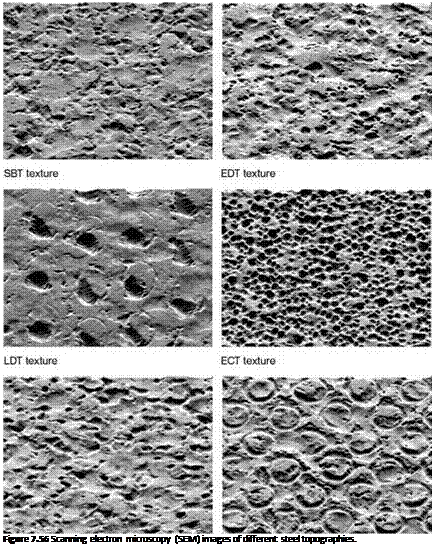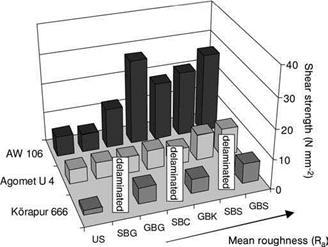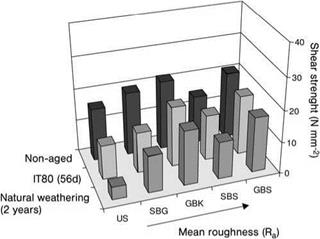Long-term influences may completely change the strength characteristics of bondings. This is convincingly demonstrated by a comparison of the residual strength
|
Figure 7.54 Tensile shear strength of aged (IT 80) mild steel bondings as a function of the surface preparation and the type of adhesive used. |
values of mild steel bondings [9] following aging in 80 °C hot water (IT 80) for eight weeks (Figure 7.54) with the strength values obtained with non-aged bondings (see the discussion at the start of Section 7.7.1).
In the test run performed with the epoxy-resin adhesive AW 106, following an eight-week aging period in IT 80, the reference samples and the samples blasted with SBG and GBG failed, with an apparent adhesive failure pattern, at very low strength values (below 10 N mm~2; Table 7.5), corresponding to 30-50% ofthe initial strength.
|
Table 7.5 Characteristics of fracture surfaces of aged (IT 80) mild steel bondings.
AF = adhesive failure (see Section 7.2.6); CF = cohesive failure; delam. = delaminated; PUR = polyurethane resin. |
Samples blasted with shot-blast ceramic (SBC), grit-blast corundum (GBK), shot — blast steel (SBS) and grit-blast steel (GBS) failed at significantly higher strength values (in the range of 20 N mm-2), showing a cohesive failure pattern near the adhesive/substrate interface, corresponding to 90% of the initial strength in the nonaged condition, with the exception of samples blasted with SBS, which only achieved 70%. Surface preparation with SBG and grit-blast glass (GBG) did not significantly improve the durability in contrast to blasting with SBC, GBK and GBS, which clearly improved the durability compared to the reference samples. Within the standard deviation, there was virtually no loss in tensile shear strength and no modification of the failure pattern compared to the results obtained with non-aged samples.
When the acrylate adhesive was used, the reference samples failed at very low strength values (ca. 5 N mm-2), corresponding to 25% ofthe initial strength. At visual inspection, adhesive failure patterns were found: the surface preparation with SBG, GBG, SBC and GBK resulted in near-identical strength values, but with different failure patterns. There was adhesive failure without bond-line corrosion at the edges ofthe bonding area, and cohesive failure in the core area. With these samples, around 30% of the initial strength of non-aged samples was obtained. Only when using SBS and GBS was there a slight increase in residual strength (to around 45%), indicating a tendency towards improved aging resistance. In this test run, the decrease in strength was caused by a diminishment of the bonding area due to aging. It should be noted that the size ofthe remaining bonding area with a cohesive failure pattern depends on the type of abrasive medium used. Compared to the reference sample, a slight improvement can be achieved with steel abrasives.
In the test run performed with a polyurethane adhesive system, the reference samples had a residual strength of 1.6 N mm-2 following aging, corresponding to 10% ofthe shear strength in the non-aged condition, and an adhesive failure pattern was detected. It becomes obvious that the aging characteristics are significantly improved by a surface preparation using angular blasting media such as GBG, GBK and GBS, yielding residual strengths of around 40-50% ofthe initial value. On the other hand, all samples blasted with spherical blasting media such as SBG, SBC and SBS failed during aging by delamination ofthe bonding areas that became detached after an aging period of approximately six weeks. No further destructive testing was possible with these samples.
It is rather interesting that, with regard to the durability of steel bondings, the results obtained with the immersion test performed at 80 ° C during eight weeks were similar to those obtained with a two-year outdoor weathering test performed in Kaiserslautern (Germany) without using any corrosive additives (Figure 7.55).
The adhesive used was a cold-setting epoxy resin-based model adhesive with an amine hardener that was similar to AW 106 and had similar failure patterns. However, the degrees of damage following short-term aging procedures are rarely similar to those following long-term climatic exposure, and they do not occur when exposure to corrosive media is involved which may impair the bondings in other ways. This applies especially to steels that are susceptible to rusting. Usually, though with some exceptions, these materials are not employed without a proper corrosion protection. Hence, these bondings are tested after subsequent application of a
|
Figure 7.55 Comparison of results obtained after different aging procedures. |
corrosion protection that is similar to that used on the planned component. With all test methods, bondings that are intended for use in automobiles, for example, are e — coated prior to long-term exposure.
Initially, it seems obvious to suspect the surface morphology in the micrometer range, generated by blasting with different media, as being the reason for the differences in durability. However, the following example, of results obtained with bonded textured body steel frequently used in automobile construction, shows this not to be the case (Figure 7.56).
Without discussing detail, may it suffice to say that all topographies were embossed on a steel coil using an embossing roller. The different textures had a similar chemical composition, as demonstrated by analysis, but the roughness and peak values of the sheets were quite different (Figure 7.57).
The adherents were bonded with hot-setting epoxy-resin-based Terokal 5026 adhesive and (as mentioned above) the samples were e-coated. The tensile shear strengths of all bondings in the non-aged and aged conditions, obtained following different aging procedures, are shown in Figure 7.58.
It becomes clear that the different topographies have virtually no influence on the strength and durability behavior of steel bondings and the failure patterns observed (Table 7.6). However, accelerated outdoor weathering, in combination with salt spray application once weekly, resulted in severe bond-line corrosion of the bonded areas despite e-coating, which usually does not occur in practice (e. g. with long-term use of bonded joints in a car). This is a typical example showing that accelerated long-term tests may also yield unrealistic results.
As expected, stainless steel bondings are less susceptible to corrosion. The results obtained with X5CrNi18-10 special stainless steel bondings with smooth surfaces, and with surfaces blasted in the steel mill (steels A and B) and intentionally contaminated with protective oil, are shown in Figure 7.59. Different hot-setting epoxy-resin-based adhesives were used, one of which was a formulation of epoxy
 |
resin and polyurethane. Again, without discussing detail, it was noted that the durability of special steel bonded with modern adhesives used in the automobile industry was quite satisfactory [14].
The above-mentioned investigation revealed that austenitic stainless steel, which formerly was considered to be difficult to bond, can be bonded perfectly with coldsetting adhesives to form a durable joint. Chemical or physical surface preparation only slightly improved the strength and durability, and in general could be dispensed with. With regards to the failure pattern, suffice it to say that with non-aged special
steel bondings, a visual inspection frequently revealed adhesive failure or particular cohesive failure near the adhesive/substrate interface. However, in contrast to other adherent materials, this did not represent any major disadvantage.
7.7.8
 30 октября, 2015
30 октября, 2015  Pokraskin
Pokraskin 

 Опубликовано в рубрике
Опубликовано в рубрике 